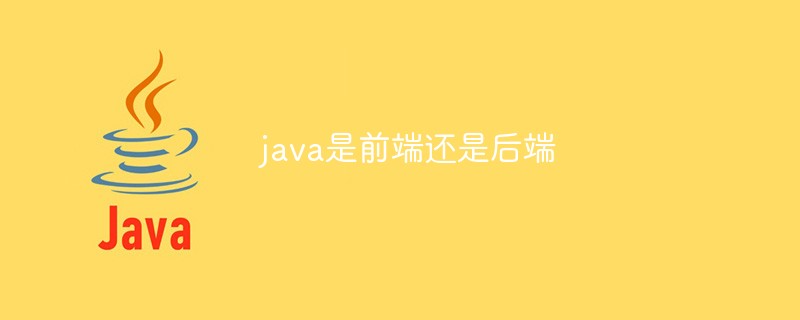java is a back-end language, a high-level programming language launched by Sun Microsystems in May 1995; java language can run on multiple platforms, such as Windows, Mac OS and other UNIX versions system.

Recommended: "java Video Tutorial"
Java was launched by Sun Microsystems in May 1995 High-level programming language.
Java can run on multiple platforms, such as Windows, Mac OS and other UNIX versions of systems.
Later, Sun was acquired by Oracle (Oracle), and Java became an Oracle product.
Java is divided into three systems:
JavaSE (J2SE) (Java2 Platform Standard Edition, java platform standard edition)
JavaEE (J2EE) (Java 2 Platform, Enterprise Edition, java platform Enterprise Edition)
JavaME (J2ME) (Java 2 Platform Micro Edition, java platform micro version).
In June 2005, the JavaOne conference was held, and SUN released Java SE 6. By this time, various versions of Java had been renamed to remove the number "2": J2EE was renamed Java EE, J2SE was renamed Java SE, and J2ME was renamed Java ME.
Main features
Java language is simple:
The syntax of Java language is very close to C language and C language, making most programmers Very easy to learn and use. On the other hand, Java discards those features of C that are rarely used, difficult to understand, and confusing, such as operator overloading, multiple inheritance, and automatic casts. In particular, the Java language does not use pointers, but references. It also provides automatic allocation and recycling of memory space, so that programmers do not have to worry about memory management.
The Java language is object-oriented:
The Java language provides object-oriented features such as classes, interfaces, and inheritance. For the sake of simplicity, it only supports single inheritance between classes, but supports interfaces. Multiple inheritance between classes and interfaces, and supports the implementation mechanism between classes and interfaces (the keyword is implements). The Java language fully supports dynamic binding, while the C language only uses dynamic binding for virtual functions. In short, the Java language is a pure object-oriented programming language.
The Java language is distributed:
The Java language supports the development of Internet applications. In the basic Java application programming interface, there is a network application programming interface (java net), which provides users with Class libraries for network application programming, including URL, URLConnection, Socket, ServerSocket, etc. Java's RMI (Remote Method Activation) mechanism is also an important means of developing distributed applications.
The Java language is robust:
Java’s strong typing mechanism, exception handling, automatic garbage collection, etc. are important guarantees for the robustness of Java programs. Discarding pointers is a wise choice by Java. Java's security checking mechanism makes Java more robust.
The Java language is safe:
Java is usually used in a network environment. For this reason, Java provides a security mechanism to prevent malicious code attacks. In addition to the many security features of the Java language, Java has a security prevention mechanism (class ClassLoader) for classes downloaded through the network, such as allocating different name spaces to prevent replacement of local classes of the same name, byte code inspection, and providing security management Mechanism (class SecurityManager) allows Java applications to set up security sentries.
The Java language is architecture-neutral:
Java programs (files with the suffix java) are compiled into an architecture-neutral bytecode format (files with the suffix class) on the Java platform ), which can then run on any system that implements the Java platform. This approach is suitable for heterogeneous network environments and software distribution.
The Java language is portable:
This portability comes from architecture neutrality. In addition, Java also strictly stipulates the length of each basic data type. The Java system itself is also highly portable. The Java compiler is implemented in Java, and the Java running environment is implemented in ANSI C.
The Java language is interpreted:
As mentioned earlier, Java programs are compiled into bytecode format on the Java platform and can then be run on any system that implements this Java platform . At runtime, the Java interpreter in the Java platform interprets and executes these bytecodes, and the classes required during the execution are loaded into the running environment during the connection phase.
Java is high-performance:
Compared with those interpreted high-level scripting languages, Java is indeed high-performance. In fact, with the development of JIT (Just-In-Time) compiler technology, Java's running speed is getting closer and closer to C.
The Java language is multi-threaded:
In the Java language, a thread is a special object that must be created by the Thread class or its descendants (grandchildren). There are usually two ways to create a thread: first, use a constructor subclass with the type Thread(Runnable) to wrap an object that implements the Runnable interface into a thread; second, derive a subclass from the Thread class and override it run method, the object created using this subclass is a thread. It is worth noting that the Thread class has implemented the Runnable interface, so any thread has its run method, and the run method contains the code to be run by the thread. The activity of a thread is controlled by a set of methods. The Java language supports the simultaneous execution of multiple threads and provides a synchronization mechanism between multiple threads (the keyword is synchronized).
The Java language is dynamic:
One of the design goals of the Java language is to adapt to dynamically changing environments. The classes required by Java programs can be dynamically loaded into the running environment, or the required classes can be loaded through the network. This also facilitates software upgrades. In addition, classes in Java have a run-time representation that enables run-time type checking.
The above is the detailed content of Is java front-end or back-end?. For more information, please follow other related articles on the PHP Chinese website!